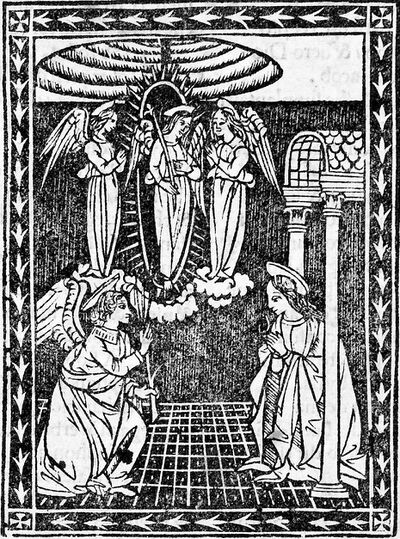Medieval stage machinery in churches[edit]
Religious theatre in the Middle Ages featured not only mortal beings, as in secular theatre, but also devils, angels, God, divine beings, ascensions, miracles. Machines were created to allow the required actions of the performance to be carried out.
In the Middle Ages, Christian churches became spaces for experimentation, investigating how to implement different types of stage machinery. The mechanisms used in the religious plays evolved over time and allowed for the constant improvement of the scenographic effects, such as flying characters or celestial spheres, required to present various scenes from the Bible.
For flying people or scenic elements, there were devices with ropes or cables, which have two ends fixed, one at a higher point and the other at a lower point or on the ground, thus allowing horizontal, inclined or even vertical movement. Examples are the star of the adoration of the Three Kings and the divine ray of the Holy Spirit, the dove of the Annunciation and the conception of the Virgin Mary, as well as the Ascension, the Baptism of Christ, and representations of the Pentecost.
Another category of mechanism is based on a device attached to a single point at the top, where a winch is located, which allows the figures or personages to be raised and lowered. This machinery allows purely vertical movement – the Mandorla. In Christian iconography, the mandorla (literally, almond) or vesica de piscis is the divine light that surrounds holy characters, including angels, when they appear on earth. It is often depicted as an almond shape, hence its name. It is also a machine used to raise and lower people from heaven. It has an iron arch in the centre of which is a circular wooden base where the central figure and the image of Mary are placed. The mandorla was moved up and down by means of a system of pulleys and ropes, while candles provided lighting. In the apparatus there are hidden tubes where the candles are placed to give the most impressive and unexpected effect of illumination – the tubes raised and lowered, so revealing or hiding the light as required. Cloth or wadding was used to create clouds, on or surrounding the mandorla, completing the effect.
These devices were further developed throughout the Middle Ages and into the Renaissance. In his book, Lives of the Most Eminent Painters, Sculptors & Architects, Giorgio Vasari describes Brunelleschi’s representation of The Annunciation in the Church of San Felice (1435-1439), where a dome illuminated by candles held on cloud-like corbels represented the sky:
[Brunelleschi] had suspended, between two of the beams that supported the roof of the church, the half of a globe in the shape of an empty bowl, or rather, a barber basin, with the rim downwards […]. At the foot of the inner edge it had certain wooden brackets […]; on each of these brackets there was placed […] boys, dressed like angels […]. From the aforesaid ring there issued a very stout bar of iron […]. The said stout bar of iron had eight arms, spreading out in an arc large enough to fill the space within the hollow half globe, and at the end of each arm there was a stand about the size of a trencher; on each stand was a boy about nine years old, well secured by an iron soldered on to the upper part of the arm, but loosely enough to allow him to turn in every direction.
These eight angels, supported by the said iron, were lowered from the space within the half-globe […] In the midst of this cluster of eight angels – for so was it rightly called – was a mandorla of copper, hollow within, wherein were many holes showing certain little lamps fixed on iron bars in the form of tubes; which lamps, on the touching of a spring which could be pressed down, were all hidden within the mandorla of copper, whereas, when the spring was not pressed down, all the lamps could be seen alight through some holes therein.
The stage mechanics, lighting and scenic elements combined to create a remarkable effect. As the scene of the Annunciation played out,
there was a God the Father on the outer edge of the globe, surrounded by angels similar to those named above and supported by irons, in such wise that the Heaven, the God the Father, the cluster, and the mandorla, with innumerable lights and very sweet music, truly represented Paradise.
Through the Middle Ages, stage machinery familiar to us today was used to bring to life the stories of the bible, creating divine beings, ascensions and miracles for the audience to marvel at, reinforcing the Christian faith.

